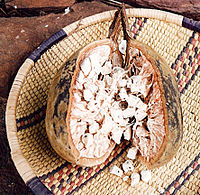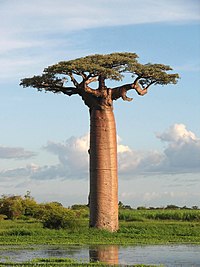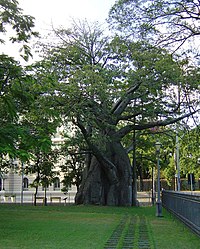Adansonia
It has been suggested that Baobab fruit be merged into this article. (Discuss) Proposed since August 2008. |
| Baobab | |
|---|---|

| |
| African Baobab tree close to Kayes. | |
| Scientific classification | |
| Kingdom: | |
| (unranked): | |
| (unranked): | |
| (unranked): | |
| Order: | |
| Family: | |
| Genus: | Adansonia |
| Species | |
|
See text | |

Baobab is the common name of a genus (Adansonia) containing eight species of trees, native to Madagascar (having six species), mainland Africa and Australia (one species in each). The mainland African species also occurs on Madagascar, but it is not a native of that island.
Other common names include boab, boaboa, bottle tree, upside-down tree, and monkey bread tree. The species reach heights of 5 to 30 metres (16 to 98 ft) and trunk diameters of 7 to 11 metres (23 to 36 ft). An African Baobab specimen in Limpopo Province, South Africa, often considered the largest example alive, has a circumference of 47 metres (154 ft) and an average diameter of 15 metres (49 ft).[1]
Some baobabs are reputed to be many thousands of years old, which is difficult to verify as the wood does not produce annual growth rings, though radiocarbon dating may be able to provide age data.
The Malagasy species are important components of the Madagascar dry deciduous forests. Within that biome, A. madagascariensis and A. rubrostipa occur specifically in the Anjajavy Forest, sometimes growing out of the tsingy limestone itself.
Beginning in 2008, there has been increasing interest for developing baobab as a nutrient-rich raw material for consumer products.[2][3]
Species
- Adansonia digitata – African Baobab (western, northeastern, central & southern Africa)
- Adansonia grandidieri – Grandidier's Baobab (Madagascar)
- Adansonia gregorii (syn. A. gibbosa) – Boab or Australian Baobab (northwest Australia)
- Adansonia madagascariensis – Madagascar Baobab (Madagascar)
- Adansonia perrieri – Perrier's Baobab (North Madagascar)
- Adansonia rubrostipa (syn. A. fony) – Fony Baobab (Madagascar)
- Adansonia suarezensis – Suarez Baobab (Diego Suarez, Madagascar)
- Adansonia za – Za Baobab (Madagascar)
The name Adansonia honours Michel Adanson, the French naturalist and explorer who described A. digitata.
Water storage
Baobabs store water inside the swollen trunk (up to 120,000 litres (32,000 US gal)) to endure the harsh drought conditions particular to each region.[4] All occur in seasonally arid areas, and are deciduous, shedding their leaves during the dry season.
Uses

The leaves are commonly used as a leaf vegetable throughout the area of mainland African distribution, including Malawi, Zimbabwe, and the Sahel. They are eaten both fresh and as a dry powder. In Nigeria, the leaves are locally known as kuka, and are used to make kuka soup.
The fruit is nutritious possibly having more vitamin C than oranges and exceeding the calcium content of cow's milk.[5] Also known as "sour gourd" or "monkey's bread", the dry fruit pulp separated from seeds and fibers is eaten directly or mixed into porridge or milk. In Malawi, the fruit pulp is used to make a nutrient-rich juice.[5]
The fruit was once used in the production of tartar sauce.[2] In various parts of East Africa, the dry fruit pulp is covered in sugary coating (usually with red coloring) and sold in packages as a sweet and sour candy called "ubuyu".
The seeds are mostly used as a thickener for soups, but may also be fermented into a seasoning, roasted for direct consumption, or pounded to extract vegetable oil. The tree also provides a source of fiber, dye, and fuel.
Indigenous Australians used baobabs as a source of water and food, and used leaves medicinally. They also painted and carved the outside of the fruits and wore them as ornaments. A very large, hollow baobab south of Derby, Western Australia was used in the 1890s as a prison for Aboriginal convicts on their way to Derby for sentencing. The Boab Prison Tree still stands and is now a tourist attraction.
The whole fruit of the baobab is not available in the EU as current EU legislations from 1997 dictate that foods not commonly consumed in the EU have to be formally approved before going on sale. On 15 July 2008, the EU authorised the use of Baobab Dried Fruit Pulp as a food ingredient in smoothies and cereal bars Food Standards Agency website. More recently, Baobab Dried Fruit Pulp achieved GRAS status for these same food uses FDA website.
Traditional uses of the whole fruit are unlikely outside of Africa as the fruit will be processed for export as a white powder with a cheese-like texture to be used as an ingredient in products.[5]
Culture and myths



- The national tree of Madagascar.[citation needed]
- Used for bonsai (the most popular being A. digitata).
- Known colloquially as "upside-down tree", it is cited in African lore: after creation, each of the animals was given a tree to plant and the hyena planted the baobab upside-down.[citation needed]
- Tabaldi is the name of the Baobab tree in Sudan and its fruit is Gongalis. Baobab's trunk is used as a tank to store water. People in west Sudan use the hollow in the trunk to save water in the rain season. Gongalis is used to make juice or to cure stomach and other diseases.
- Bark may have been used hundreds of years ago in Africa as a backscratcher or toothbrush.
- Having a distinctive foul smell, tree parts may have been used by primitive tribes to ward off evil spirits, making the tree known in African folklore as "God's Thumb."
- Rafiki, in The Lion King, makes his home in a baobab tree.
- Ernst Haeckel mentions "monkey bread-fruit trees (Adansonia)" in his The History of Creation (Chap. 29), and claims that their "individual life exceeds a period of five thousand years".
- The owners of Sunland Farm in Limpopo, South Africa have built a pub called "The Big Baobab Pub" inside the hollow trunk of a 22 metres (72 ft) high baobab. The tree, which is 47m (155ft) in circumference, is reported to have been carbon dated at over 6,000 years old.[6][7]
- Baobabs are cited in the The Little Prince as a tree that may "split" a small planet into pieces.
Gallery
-
Baobab in Kruger National Park, South Africa
-
Boab Adansonia gregorii in Australia
-
Baobab flowers in Mulund, Mumbai, India
References
Notes
- ^ "Big Baobab Facts". Retrieved 2008-01-08.
- ^ a b "Scientists predict African fruit trees could help solve major public health problem". Bioversity International. Retrieved 2008-10-01.
- ^ Hills S. Baobab goes for GRAS ahead of 2010 World Cup, FoodNavigator.com-USA, September 30, 2008 [1]
- ^ "The Baobab tree in Senegal". Retrieved 2008-10-01.
- ^ a b c "New exotic fruit to hit UK shops". BBC. Retrieved 2008-07-15.
- ^ Fancy a pint in the world's only bar that's INSIDE a tree?, Daily Mail, December 2007 Retrieved 2007-12-20
- ^ Of all the gin joints in all the world, Tristan McConnell in the Big Baobab Pub, Modjadjiskloof, South Africa, The Times, January 2007, Retrieved 2007-12-20
Further reading
- Colin, Tudge (2006, 2005). The Tree: A Natural History of What Trees Are, How They Live, and Why They Matter (1st U.S. edition ed.). New York, NY: Crown Publishers. ISBN 1400050367. OCLC 64336118.
{{cite book}}:|edition=has extra text (help); Check date values in:|year=(help) - Lowe, Pat. The Boab Tree. Port Melbourne, Australia: Lothian. ISBN 0850919126. OCLC 39079651.
- Pakenham, Thomas (2004). The Remarkable Baobab (1st American edition ed.). New York, NY: Norton. ISBN 0393059898. OCLC 56844554.
{{cite book}}:|edition=has extra text (help) - Watson, Rupert (2007). The African Baobab. Cape Town, South Africa; London, England: Struik; New Holland. ISBN 9781770074309. OCLC 163617611.
- Wickens, G. E. (2008). The Baobabs: Pachycauls of Africa, Madagascar and Australia. Berlin, Germany; New York, NY: Springer Verlag. ISBN 9781402064302. OCLC 166358049.
{{cite book}}: Unknown parameter|coauthors=ignored (|author=suggested) (help)
- Braun, K. (1900) Beiträge zur Anatomie der Adansonia digitata L. F. Reinhardt, Universitäts-Buchdruckerei, Basel, OCLC 15926986
- Baum, D. A., Small, R. L., & Wendel, J. F. (1998). Biogeography and floral evolution of baobabs (Adansonia, Bombacaceae) as inferred from multiple data sets. Systematic Biology 47 (2): 181-207.






